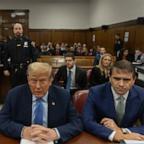Larry Brown is punished again, and should anyone be surprised?
— -- Larry Brown already is in the Hall of Fame, inducted way back in 2002, or when he only had taken two programs to a Final Four and postseason bans.
Now the SMU Mustangs coach ought to be fitted for his own wing in Springfield. His résumé, after all, is unmatched. He is a perfect 3-for-3, having worked as a head coach at just three NCAA Division I institutions (UCLA, Kansas and SMU), yet managing to lead all three into an unplanned March vacation.
You don't find that quality of work just anywhere.
Not even other famous outlaws can live up to those standards. Jerry Tarkanian and Jim Harrick each got three schools in trouble, but neither could quite reach the postseason-ban triumvirate level.
The NCAA added the latest addendum to Brown's biography Tuesday, announcing that SMU would be barred from this year's postseason and that Brown would be suspended for 30 percent of the Mustangs' games. The penalties stem from a lengthy academic fraud investigation involving a former assistant coach and basketball administrator at SMU, including allegations that the two helped guard Keith Frazier to become eligible.
Brown is not alleged to have helped Frazier, but he did fail to report the violation for a month and initially lied when asked about it by the NCAA. That opened the door for the NCAA to use its new enforcement muscle, invoking a "failure to promote an atmosphere of compliance" rule that precludes coaches from using the clueless defense to avoid penalty.
So Brown will sit out around nine games this season, joining Jim Boeheim in the ignominious class of Hall of Fame coaches suspended for a portion of the 2015-16 season.
Frankly, that's the only real surprise in any of this, that the peripatetic Brown actually will have to face the mess he himself created. Usually he's skated out of town by now, leaving others to pick up the detritus he left behind. When UCLA was disciplined in 1981, Brown already had moved on to the New Jersey Nets. When the hammer dropped on Kansas, he was back in the NBA, at San Antonio.
At least this time he'll have to sit back and watch his SMU team, a favorite to win the American Athletic Conference and make a good run in the NCAA tournament, shutter its season before Selection Sunday. At least this time he'll have to look seniors Nic Moore and Markus Kennedy in the eye when they are denied their shining moments.
At least this time, Brown may actually feel the sting of what he's done.
Otherwise, there's not much more than "Dog bites man" here, to use the old newspaper analogy.
Is university president R. Gerald Turner, who reportedly pushed to hire Brown, really surprised? Is anyone? Larry Brown is a brilliant basketball mind. He's an engaging and entertaining talker. And he no more belongs in college athletics than Lance Armstrong would teaching an ethics class.
This is a man who reportedly used a kid who lived in his own Lawrence, Kansas, home, Mike Marshall, as his bagman at KU and whose infractions at Kansas were so egregious that when asked whether the Jayhawks were eligible for the death penalty (dealt, ironically, only to SMU in 1987), then-NCAA enforcement director David Berst replied blithely, "Kansas was on the bubble, so to speak.''
That was the most recent collegiate anecdotal evidence SMU had when the school hired Brown.
Yet he hired him, anyway. If you don't know why, you haven't been paying attention for the last 50 years, because winning trumps everything.
Certainly we can pause to point out the absurdity here of a penalty system that holds institutions accountable for "an aggregate" of transgressions -- as Committee on Infractions chair and Pepperdine chancellor Michael Adams termed it Tuesday -- but feels no such need to look at the individuals that make up the institutions when they are repeat offenders.
"We don't have the right to go through an individual's history in a case like this,'' Adams said.
Ultimately, though, the system is only as fallible as the individuals that perpetuate it. In order for Brown to continue to break the rules, someone has to hire him.
After years of irrelevance, SMU wanted to get better and get better fast, so in came Brown. Former athletic director Steve Orsini already had swung and missed on Tommy Amaker, Buzz Williams and others when he turned to Brown, 71 years old, bored, unemployed, more than two decades removed from his latest walk on a college basketball sideline, NCAA baggage at his feet.
Two years later, the Mustangs were 27-10 and in the NIT. A year ago, they landed the nation's top recruit, Emmanuel Mudiay (who notably left to play overseas amid eligibility and amateurism questions) and finished 27-7 and made it to the NCAA tournament.
And now on the precipice of Year 4, the school is back in the NCAA's bad graces, trying to figure out how a Top 25 program can find value in a sport that only values the postseason.
The answer is, it can't.
SMU basketball will pay a huge price for its coach's transgressions, its season not only labeled with the dreaded asterisk but worse, forever tagged with the looming question of "What if?"
What if the Mustangs were able to play in the NCAA tournament?
What if this hadn't happened?
And maybe above all else, what if the school simply hadn't hired Larry Brown?




